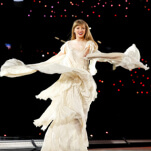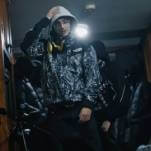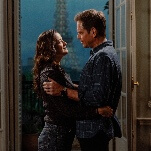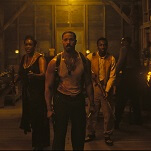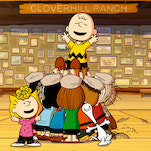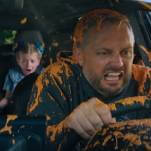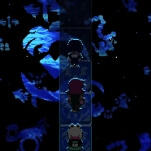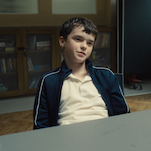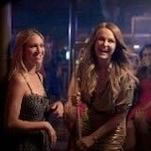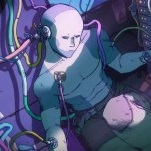Martyrs
“I’m not sure you have made the right decision.” —director Pascal Laugier, in his video introduction to the Martyrs DVD
Martyrs is a black hole. It’s not an entertaining film. It’s not a hopeful or redemptive film. It’s a film to be reckoned with, a repository of darkness and evil that pushes the “extreme horror” genre as far as it can possibly go. (Takashi Miike has to feel pretty miffed about that.) Never released theatrically in the United States—it was bought by the Weinstein Company, but according to an interview with director Pascal Laugier, Bob Weinstein himself couldn’t make it to the end—Martyrs now exists as a dare on DVD, the film equivalent of kids egging each other into checking out the scary-looking house down the road. It sustains a heightened, steadily ratcheted anxiety and manufactures increasingly repulsive and sickeningly provocative imagery, all without even teasing the possibility of relief. It’s sick shit, in other words, and if you’re in the camp that finds nothing edifying about the experience of watching it, you’re likely to want to see it (and perhaps Laugier) dropped from a great height.
And yet, like many of the best—or at least most notorious—modern horror films, Martyrs is unmistakably stained by the era in which it was made. In interviews, Laugier has said the film arose from his sad intuition that “our occidental urban societies are filled with despair and brutality,” a feeling that “we’re living a world close to its own end.” To a degree, his film could be fairly slagged as one that indulges in stylish, art-horror nihilism for its own sake, particularly in its direct and exploitative evocation of real 20th-century genocide. But his is also a movie about torture, revenge, and the seemingly boundless capacity for human cruelty, and in that sense, it’s unquestionably relevant and a legitimate comment on the world as it is right now. Martyrs has naturally provoked a sharply polarized response, but my own response is more troubled and complicated—mostly positive and admiring of Laugier’s audacious and singular vision, but unsettled by some of the dubious places he chooses to go.
Most of the conversation people have about Martyrs concerns its final 30 minutes or so, and for good reason: That’s when the film shifts gears and heads into the torture sequences that have given it such notoriety. (And definitively trumped the most harrowing moments in other French extreme horror movies like High Tension, Frontier(s), and Inside.) What they forget is that the first hour is completely gripping and suspenseful in an entirely different and infinitely more palatable way. Yes, it’s bloody and disturbing in its own right, but it’s also genuinely charged and full of arresting ambiguity, far from the clinical sickness that follows in the third act. Torture isn’t in the foreground yet, but informs the action, as a once-abused child grows up to exact a revenge that may be just or may be the product of a haunted and irretrievably damaged mind.
[Warning: Spoilers from here on out. If you have any intention of seeing Martyrs with a relatively clean slate, here’s your cue to exit and come back later.]
Opening with a steel-door slam that pays homage to the film’s more respected ancestor, The Texas Chain Saw Massacre, the prologue finds a mutilated young girl hobbling and screaming in flight from the warehouse in which she’s been kept and tortured. When she lands at an orphanage, Lucie (played later by Mylène Jampanoï) proves remote and erratic, and she’s bothered by nightmares that bleed into her waking life. Lucie finds a friend in a fellow orphan named Anna (played later by Morjana Alaoui), and 15 years later, Anna helps Lucie find the sickos responsible for abusing her. The search leads Lucie and her double-barreled shotgun to a bourgeois household, where mom and dad are sitting down for breakfast with their normal teenaged children. Here’s a NSFW taste of the before and (slightly) after:
Once she finishes mercilessly dispatching of this family—even the innocents, in a Medea-like act of all-consuming fury—Lucie summons Anna to help her dispose of the bodies. And right away, Anna’s dilemma is clear: She loves her friend and likely feels Lucie’s torturers deserve whatever gruesome fate Lucie has planned for them, but she’s not convinced these are the culprits. She doesn’t trust the clarity of Lucie’s memory and she’s not reassured by reports of a hostile figure—the same mutilated creature that’s appeared to Lucie in dreams—still skittering about the house, straight razor in hand. When the mother of the house turns out to be still alive, Anna furtively sets about trying to free her, now convinced that Lucie’s inner demons have tragically screwed her perception.
What happens next is fiendishly clever on Laugier’s part, because it’s one of those ironic moments, like the end of George Romero’s Martin, that definitively resolves a question without answering it. Lucie catches Anna trying to drag the mother to safety and blows the mother away; Lucie’s then seized by a creature that slashes, beats, and eventually kills her, but turns out to be a deadly manifestation of her imagination. Lucie’s suicide (of sorts) may seem like sad confirmation to Anna that her friend was simply crazy, but she can’t know for sure and neither can we. And though we in the audience are aware that there’s plenty of movie left, Laugier lets that sick ambiguity linger before dropping the other shoe. It’s a great piece of filmmaking and I fear that arguments over the film’s subsequent content have kept that from being acknowledged.
Then again, the last half hour leaves an awfully big welt. A little investigation leads Anna into a secret, high-tech underground corridor where she soon discovers that her friend was right. And predictably, after finding a naked, emaciated, slashed-up young woman in a torture dungeon and trying to save her, Anna is confronted by a group of black-clad thugs who hold her captive. Their leader is “Mademoiselle,” a sinister middle-aged woman who tells Anna about her macabre cult, which involves systematically torturing “martyrs” under the belief that their extreme pain will provide a window to the afterlife. Her speech is the only talky scene in an otherwise visceral film, and it’s here where the dubiousness starts:

